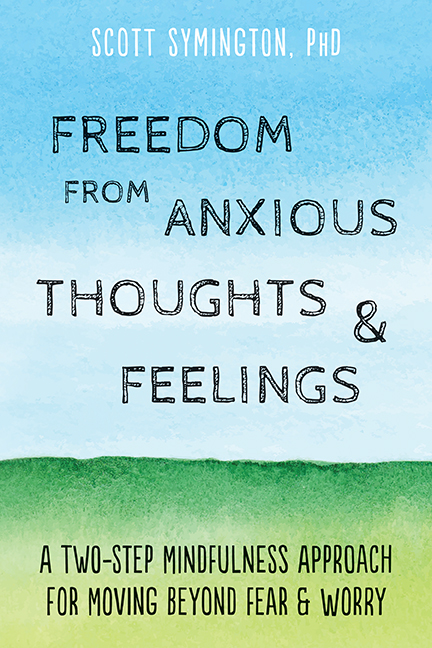By Scott Symington, PhD, author of Freedom from Anxious Thoughts and Feelings
Do you ever get stuck on distressing thoughts that continuously loop through your mind? How am I going to get all this work done? What if I can’t sleep tonight? I wonder if the boss is mad at me? Most of us, at one time or another, experience these anxious preoccupations where our minds can’t let go of a perceived threat. We may recognize that our thinking isn’t helpful. We may even be familiar with evidenced-based practices, such as applying mindful acceptance to our experience. Yet, in the midst of worries and anxious feelings, it can be hard to translate our psychological knowledge and intention not to worry into meaningful action. In other words, we’re not sure what to do on the inside—the specific mental and emotional steps—to make the distressing thoughts and feelings less powerful inside us.
Two-Screen Method
To help clients break free from anxious worries, I developed a user-friendly application of mindfulness called the Two-Screen Method (TSM). It’s an approach that allows you to quickly organize your internal experience, see what’s happening, and relate to internal challenges with psychological wisdom. Here’s how it works. You imagine your internal world as a media room with two screens. On the forward-facing wall is the front screen, which represents the present moment and all the thoughts, feelings, and images that translate into well-being and a sense of connection to what’s important in life. When you say to yourself, I’m in a good space right now, you’re connected to the internal activity showing up on the front screen. Life may not be perfect, but there is a general feeling of contentment. Off to the right, however, still inside your mind, is a side screen. This is the place where the fears, worries, unhealthy preoccupations, and destructive moods show up. With this mental image of two screens, TSM shows you how to de-energize the problematic thoughts and feelings showing up on the side screen, while cultivating your ability to be in the present moment and express the best parts of who you are on the front screen.
Applying the Two-Screen Method
In Freedom from Anxious Thoughts and Feelings, I have readers develop a personal profile of their anxious side screen, so they can detect the presence of worry early. Readers identify the specific thoughts, feelings, images, and physical sensations that represent their anxious worrying. Once they have a solid grasp of their side screen, including when it tends to light up, they begin applying the two steps of TSM.
The first step is accepting the presence of the unwelcome thoughts and feelings showing up on the side screen, while redirecting attention to the front screen. Let’s take a closer look.
Step One: Accept & Redirect
Let’s say you’re cleaning up after dinner and the thought comes into your mind, what if Luke gets bad grades this semester? He’ll never get into a good college! You recognize parenting is a source of worry. You get anxious about uncertain outcomes and often fear you’re not doing enough for your kids. You’re also aware that it’s eight o’clock at night and tomorrow is a full day. Even though your mind wants to invest in the parenting concern scrolling across the side screen, you make the decision to shift your focus off the side screen, while accepting the presence of the unresolved worry in your peripheral vision. Each time your mind travels back to the side screen, you repeatedly—and mindfully—redirect your attention back to the front screen. What helps in these spaces, when you’re trying not to invest in the side screen, is having a healthy alternative home for your attention and life energy. That’s where TSM’s second step can help. After applying Accept & Redirect, TSM offers three front-screen anchors designed to keep you tethered to the front screen.
Step Two: Tether Your Mind to the Front Screen
When the side screen is vying for your attention, you employ one or more of the three front-screen anchors, which are Mindfulness Skills; Healthy Distractions & Activities (HDAs); and Loving Actions. Staying with our current example, instead of worrying about your son’s future, maybe you engage in a mindfulness exercise while washing the dishes (mindfulness anchor). You notice the warmth and sound of the water. You feel the pressure against your hand as you wipe the plates and so on. Rallying all five senses, you stay fully present with the act of washing dishes for several minutes. Or maybe you engage your spouse in a conversation or work on the family jigsaw puzzle for a few minutes (HDAs anchor). You could also send an encouraging text or write a quick love note your children will see in the morning (loving-action anchor). In summary, with the help of the front-screen anchors you use the presence of the side screen as a reminder and springboard to cultivate present-moment awareness and express the best parts of who you are.
Action Steps
If you’re interested in reducing worry and anxiety in your life, the Two-Screen Method can help. To get you started, here are two helpful action items.
-
In the next couple weeks, pause multiple times per day and ask yourself, where is my attention right now? See if you can catch yourself hanging out on the side screen, where you’re giving attention and energy to worries. Along with monitoring your thought life, begin building a profile of your anxious side screen—identify the times and situations that tend to activate your side screen, as well as the specific thoughts, feelings, images, and physical sensations that represent your anxious experience.
-
When your side screen is activated and the worry is trying to draw you in, apply TSM’s two steps. Accept the presence of the unwanted thoughts and feelings showing up on the side screen, while redirecting your attention and life energy to the front screen using one or more of the front-screen anchors previously described.
Scott Symington, PhD, is a clinical psychologist who is dedicated to helping adults overcome worry and anxiety, negative moods, addictive behaviors, and other conditions stealing people’s joy and freedom. In addition to a full-time private practice, he regularly speaks at professional conferences; large church groups; graduate schools and universities; and business groups, including the Young Presidents’ Organization (YPO). His career path began in the business and consulting world. Then in 1998, after much soul searching, he decided to leave a lucrative position brokering agricultural products to pursue his true passion: clinical psychology—a profession that lined up with both his head and heart.



 2024 Peace Playbook: 3 Tactics to Avoid Clashes with Your Partner
2024 Peace Playbook: 3 Tactics to Avoid Clashes with Your Partner